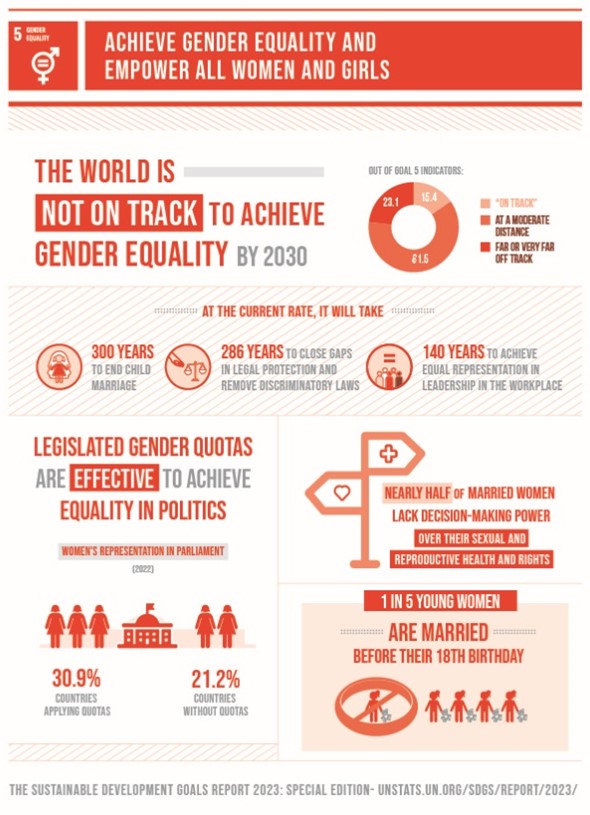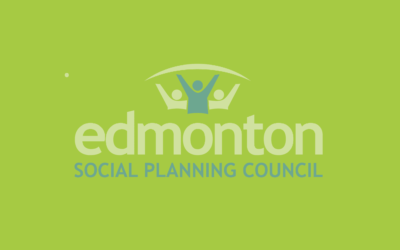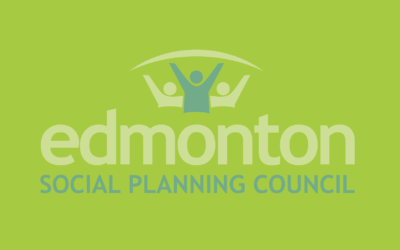Blog post: Taking the Pulse on SDG #5 – Gender Equality and Empowerment

Written by Harman Khinda, ESPC Volunteer.
With heart health month over and International Women’s Day around the corner, it seems appropriate to take the pulse on the United Nations Sustainable Development Goal (SDG) #5 – Gender Equality and Empowerment.
SDGs are an urgent call for action which are aimed at achieving developmental milestones and priorities for the betterment and prosperity of the planet as well as, people through global partnership. SDG #5 states to achieve gender equality and empower all women and girls. There are many indicators that suggest the world is not on track to achieve gender equality by 2030, as outlined in the 2030 Agenda for Sustainable Development1. It is likely that efforts have been partially hindered by the COVID-19 pandemic. International Women’s Day is observed and celebrated globally on March 8th, which is a day of collective global activism and celebration of the social, economic, cultural, and political achievements of women.2
Recently, many announcements have been made for initiatives launched both at the local and provincial levels which directly impact Albertans with respect to their goal of advocating for and advancing gender equality.
The Women’s Health Coalition-Alberta Chapter is working to advance the movement to speak openly, learn, engage, address barriers, gaps, and biases in menstrual reproductive and sexual health.3 In May 2022, the British Columbia government expanded access to free menstrual products for those in need, in an effort to reduce period poverty and alleviate the burdens of the pink tax – a widely-used term to describe not an actual tax, but a gender-discriminatory yet legal pricing practice.4,5 Similar efforts to provide free menstruation products in public spaces are being explored in Alberta.
Childcare and access to education are effective tools to promote and achieve gender equality for women across the world. Alberta had the 2nd lowest percentage of women in the working age population among the 10 provinces at 49.7%. The proportion of women in 2019 that have attained a university education increased to 29.2% from 19.5% in 2009. Between 2009 and 2019, the number of women with no degree, certificate or diploma decreased by 10.6% while the number of women with university degrees rose 81.9%.6 Women are attaining higher education in greater numbers which has a positive correlation to employment opportunities, economic security, and financial freedom. An announcement was made by the Alberta government to decrease childcare fees as the federal-provincial program expands across the country.7 This is a positive program announcement which will help alleviate the financial cost of childcare for parents and aid in increasing women’s participation in the workforce.
There are critical issues which impact achieving gender equality and empowerment. Women’s health is under researched and underfunded, with less than 4% of federal funding to women’s health research allocated to Alberta.8 Recently, the federal government announced a national pharmacare program including coverage for birth control and diabetes medication, however the Alberta government has indicated it does not intend to be part of the agreement.9 This is a financial barrier for many individuals and impacts their access to healthcare and individual autonomy. Maternal mortality is a major global occurrence. Approximately 287,000 women died during and following pregnancy and childbirth in 2020, with almost 95% of all maternal deaths occurring in low and lower middle-income countries and most could have been prevented.10 In Canada, maternal mortality rates are measured differently across provinces and territories. Different definitions are used and applied across the country, which include maternal mortality during pregnancy, within 42 days postpartum, and other ranges. It is difficult to understand the full scope of the problem which is likely leading to an undercount of maternal mortality cases.
Women and girls deserve the ability to access and participate equally in the social, economic, financial, cultural, and political realms of the world. They require support, resources, and radical change to create change. These changes will not happen overnight, however there are a few ways a person could contribute to these efforts. A person should educate themselves on local, provincial, and national efforts and initiatives focused on an area of interest. Another option is an incredible book titled “Invisible Women – Exposing Data Bias in a World Designed for Men” by Caroline Criado Perez. The path to progress is not linear, but if we choose to educate ourselves, engage in efforts within our communities and advocate for those who cannot, we will continue making progress.
Source for graphic: United Nations. (n.d.). SDG Report 2023. https://sdgs.un.org/sites/default/files/2023-08/SDG_report_2023_infographics_Goal%205.jpg

In-Text Citations Sources (APA Format)
- Transforming our world: the 2030 Agenda for Sustainable Development | Department of Economic and Social Affairs. (n.d.). https://sdgs.un.org/2030agenda
- International Women’s Day. (n.d.). International Women’s Day 2024 campaign theme: Inspire Inclusion. https://www.internationalwomensday.com/
- Women’s Health Coalition. (n.d.). Women’s Health Coalition. https://thewhc.ca/about-us/
- C. spending $750K to expand access to free menstrual products. (2022, May 27). CBC. https://www.cbc.ca/news/canada/british-columbia/free-menstrual-products-in-bc-1.6468643
- Think pink: Analyzing the history and future of the pink tax. (2022, January 10). The Varsity. https://thevarsity.ca/2022/01/09/history-and-future-of-pink-tax/
- Labour and Immigration, Government of Alberta. (2021). Alberta Labour Force Profiles I Women | 2019. https://open.alberta.ca/dataset/7bb5845d-5b9f-4026-ad6f-15b1f1be735a/resource/09420573-ec9f-4fa8-a9d8-e606686e59b7/download/lbr-alberta-labour-force-profiles-women-2019.pdf
- Fletcher, R. (2023, December 9). Alberta child-care fees set to decrease — again — as federal-provincial program expands in January. CBC. https://www.cbc.ca/news/canada/calgary/alberta-childcare-daycare-fees-grant-increases-2024-1.7053677
- Alberta Womens Health Foundation (2021) Finding the Fractures: The Pandemic, Women’s Health Disparities, and the Path to Equity https://www.albertawomenshealthfoundation.org/public/download/files/195790
- De Castillo, C. K. (2024, February 28). Alberta intends to opt out of national pharmacare plan. Global News. https://globalnews.ca/news/10316372/alberta-intends-to-opt-out-of-national-pharmacare-plan/
- World Health Organization: WHO. (2023, February 22). Maternal mortality. https://www.who.int/news-room/fact-sheets/detail/maternal-mortality
- Gomez, C., & Carman, T. (2022, October 6). Canada significantly undercounts maternal deaths, and doctors are sounding the alarm. CBC. https://www.cbc.ca/news/canada/canada-maternal-deaths-undercount-1.6600905
- United Nations. (n.d.). SDG Report 2023. https://sdgs.un.org/sites/default/files/2023-08/SDG_report_2023_infographics_Goal%205.jpg.
Sources (APA Format)
- Alberta Womens Health Foundation (2021) Finding the Fractures: The Pandemic, Women’s Health Disparities, and the Path to Equity https://www.albertawomenshealthfoundation.org/public/download/files/195790
- C. spending $750K to expand access to free menstrual products. (2022, May 27). CBC. https://www.cbc.ca/news/canada/british-columbia/free-menstrual-products-in-bc-1.6468643
- De Castillo, C. K. (2024, February 28). Alberta intends to opt out of national pharmacare plan. Global News. https://globalnews.ca/news/10316372/alberta-intends-to-opt-out-of-national-pharmacare-plan/
- Fletcher, R. (2023, December 9). Alberta child-care fees set to decrease — again — as federal-provincial program expands in January. CBC. https://www.cbc.ca/news/canada/calgary/alberta-childcare-daycare-fees-grant-increases-2024-1.7053677
- Goal 5 | Department of Economic and Social Affairs. (n.d.). https://sdgs.un.org/goals/goal5
- Gomez, C., & Carman, T. (2022, October 6). Canada significantly undercounts maternal deaths, and doctors are sounding the alarm. CBC. https://www.cbc.ca/news/canada/canada-maternal-deaths-undercount-1.6600905
- International Women’s Day. (n.d.). International Women’s Day 2024 campaign theme: Inspire Inclusion. https://www.internationalwomensday.com/
- Labour and Immigration, Government of Alberta. (2021). Alberta Labour Force Profiles I Women | 2019. https://open.alberta.ca/dataset/7bb5845d-5b9f-4026-ad6f-15b1f1be735a/resource/09420573-ec9f-4fa8-a9d8-e606686e59b7/download/lbr-alberta-labour-force-profiles-women-2019.pdf
- Think pink: Analyzing the history and future of the pink tax. (2022, January 10). The Varsity. https://thevarsity.ca/2022/01/09/history-and-future-of-pink-tax/
- Transforming our world: the 2030 Agenda for Sustainable Development | Department of Economic and Social Affairs. (n.d.). https://sdgs.un.org/2030agenda
- United Nations Statistics Division. (n.d.). — SDG indicators. https://unstats.un.org/sdgs/report/2022/Goal-05/
- United Nations. (n.d.). SDG Report 2023. https://sdgs.un.org/sites/default/files/2023-08/SDG_report_2023_infographics_Goal%205.jpg.
- Women’s Health Coalition. (n.d.). Women’s Health Coalition. https://thewhc.ca/about-us/
- World Health Organization: WHO. (2023, February 22). Maternal mortality. https://www.who.int/news-room/fact-sheets/detail/maternal-mortality



